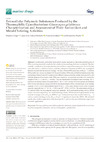Please use this identifier to cite or link to this item:
https://accedacris.ulpgc.es/jspui/handle/10553/114302
| DC Field | Value | Language |
|---|---|---|
| dc.contributor.author | Gongi, Wejdene | - |
| dc.contributor.author | Gómez Pinchetti, Juan Luis | - |
| dc.contributor.author | Cordeiro, Nereida | - |
| dc.contributor.author | Ouada, Hatem Ben | - |
| dc.date.accessioned | 2022-04-05T11:58:02Z | - |
| dc.date.available | 2022-04-05T11:58:02Z | - |
| dc.date.issued | 2022 | - |
| dc.identifier.issn | 1660-3397 | - |
| dc.identifier.other | Scopus | - |
| dc.identifier.uri | https://accedacris.ulpgc.es/handle/10553/114302 | - |
| dc.description.abstract | Cyanobacteria, particularly thermophilic strains, represent an important potential source of EPSs, harboring structural complexity that predicts diverse and specific bioactive potential. The thermophilic cyanobacteria Gloeocapsa gelatinosa, isolated from a natural hot source in Ain Echfa (Tunisia), was cultivated in a cylindrical reactor, and the production of biomass and EPSs was investigated. Results revealed that the strain is amongst the most efficient EPSs producers (0.89 g L−1) and that EPSs production was not correlated with the growth phase. EPSs were sulfated heteropolysaccharides containing carbohydrates (70%) based on nine different monosaccharides, mainly mannose (22%), and with the presence of two uronic acids. EPSs were formed by two polymers moieties with a molecular weight of 598.3 ± 7.2 and 67.2 ± 4.4 kDa. They are thermostable in temperatures exceeding 100 °C and have an anionic nature (zeta potential of −40 ± 2 mV). Atomic force microscopy showed that EPSs formed multimodal lumps with 88 nm maximum height. EPSs presented high water holding capacity (70.29 ± 2.36%) and solubility index (97.43 ± 1.24%), and a strong bivalent metal sorption capacity especially for Cu2+ (91.20 ± 1.25%) and Fe2+ (75.51 ± 0.71%). The antioxidant activity of G. gelatinosa EPSs was investigated using four methods: the β-carotene-bleaching activity, DPPH assays, iron-reducing activity, and metal-chelating activity. EPS has shown high potential as free radicals’ scavenger, with an IC50 on DPPH (0.2 g L−1) three-fold lower than ascorbic acid (0.6 g L −1) and as a metal chelating activity (IC50 = 0.4 g L−1) significantly lower than EDTA. The obtained results allow further exploration of the thermophilic G. gelatinosa for several biotechnological and industrial applications. | - |
| dc.language | eng | - |
| dc.relation | Red de Excelencia en Biotecnología Azul (Algas) de la Región Macaronésica. Consolidación, Certificación y Transferencia | - |
| dc.relation | Implementation and Sustainability of Microbial Resource Research Infrastructure for 21st Century | - |
| dc.relation.ispartof | Marine Drugs | - |
| dc.source | Marine Drugs [ISSN 1660-3397], v. 20(4), 227, (Marzo 2022) | - |
| dc.subject | 3302 Tecnología bioquímica | - |
| dc.subject | 241707 Algología (ficología) | - |
| dc.subject | 221090 Química-física de polímeros | - |
| dc.subject.other | Gloeocapsa gelatinosa | - |
| dc.subject.other | Extracellular polymeric substances | - |
| dc.subject.other | Physicochemical characterization | - |
| dc.subject.other | Functional properties | - |
| dc.subject.other | Antioxidant activity | - |
| dc.subject.other | Extremophilic | - |
| dc.subject.other | Cyanobacteria | - |
| dc.title | Extracellular Polymeric Substances Produced by the Thermophilic Cyanobacterium Gloeocapsa gelatinosa: Characterization and Assessment of Their Antioxidant and Metal-Chelating Activities | - |
| dc.type | Article | - |
| dc.type | info:eu-repo/semantics/Article | - |
| dc.identifier.doi | 10.3390/md20040227 | - |
| dc.identifier.scopus | 85128040709 | - |
| dc.contributor.orcid | NO DATA | - |
| dc.contributor.orcid | NO DATA | - |
| dc.contributor.orcid | NO DATA | - |
| dc.contributor.orcid | NO DATA | - |
| dc.contributor.authorscopusid | 57219779907 | - |
| dc.contributor.authorscopusid | 57346680900 | - |
| dc.contributor.authorscopusid | 7004319456 | - |
| dc.contributor.authorscopusid | 57208635668 | - |
| dc.identifier.eissn | 1660-3397 | - |
| dc.identifier.issue | 4 | - |
| dc.relation.volume | 20 | - |
| dc.investigacion | Ciencias | - |
| dc.type2 | Artículo | - |
| dc.description.notas | This article belongs to the Special Issue Bioactive Products from Marine Cyanobacteria and Their Potential Therapeutic Applications | - |
| dc.utils.revision | Sí | - |
| dc.date.coverdate | Abril 2022 | - |
| dc.identifier.ulpgc | Sí | - |
| dc.contributor.buulpgc | BU-BAS | - |
| dc.description.sjr | 0,813 | - |
| dc.description.jcr | 5,4 | - |
| dc.description.sjrq | Q1 | - |
| dc.description.jcrq | Q1 | - |
| dc.description.scie | SCIE | - |
| dc.description.miaricds | 10,8 | - |
| item.fulltext | Con texto completo | - |
| item.grantfulltext | open | - |
| crisitem.author.dept | GIR IOCAG: Oceanografía Biológica y Algología Aplicada | - |
| crisitem.author.dept | IU de Oceanografía y Cambio Global | - |
| crisitem.author.dept | Departamento de Biología | - |
| crisitem.author.orcid | 0000-0003-4668-0462 | - |
| crisitem.author.parentorg | IU de Oceanografía y Cambio Global | - |
| crisitem.author.fullName | Gómez Pinchetti, Juan Luis | - |
| crisitem.project.fundingProgram | Concedido | - |
| crisitem.project.principalinvestigator | Gómez Pinchetti, Juan Luis | - |
| crisitem.project.principalinvestigator | Gómez Pinchetti, Juan Luis | - |
| Appears in Collections: | Artículos | |
Items in accedaCRIS are protected by copyright, with all rights reserved, unless otherwise indicated.
